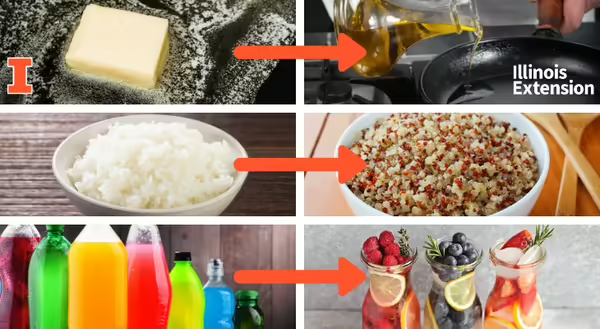
Happy National Nutrition Month®! This is a great time of year to reevaluate your eating pattern to determine if it’s working for you. Are you getting the healthful foods you need to live your best life?
An eating pattern represents all of the food and drink choices you make from day to day over the course of your lifetime. It’s more important to focus on healthy shifts you can make to your eating pattern than on individual foods. Be careful of fad diets that eliminate entire food groups (more to come on this on future posts!).
How are we, as Americans, doing?
- About three-fourths of the population has an eating pattern that is low in vegetables, fruits, dairy, and oils.
- But we’re exceeding the recommendations for added sugars, saturated fats, and sodium.
Small shifts in food choices—over the course of a week, a day, or even a meal—can make a big difference down the road. Start small with one or two shifts than gradually add more.
Small shifts are much more manageable and more sustainable than the latest fad diet. You don’t have to be perfect all the time but don’t let immediate gratification trump the feeling that healthy habits create. Shift your daily habits for optimum control.
Here are several small shifts you can try today! What other healthy shifts can you make in your eating pattern?
|
Instead of…
|
Try this! |
Benefit |
|
All-purpose flour |
Substitute up to ½ of all-purpose flour with whole wheat flour. Example: 1 cup of whole wheat flour and 1 cup all-purpose flour in a recipe calling for 2 cups all-purpose flour. |
Increased fiber/vitamins/minerals |
|
White bread |
100% whole wheat or 100% white whole wheat |
Increased fiber/vitamins/minerals |
|
White rice |
Long-grain brown rice, quinoa or bulgur wheat |
Increased fiber/vitamins/minerals |
|
Oil or butter in baking
|
Substitute part of the fat with applesauce, prune puree, mashed banana, shredded zucchini, canned pumpkin, or pureed beans. Note that liquids may need to be adjusted and there may be some taste differences. |
Less fat and more fiber/vitamins/minerals |
|
Full fat sour cream or mayonnaise
|
Low-fat versions, plain low-fat/non-fat yogurt, buttermilk, or blended cottage cheese |
Reduced fat and increased protein if using Greek yogurt over regular |
|
Meat for all your protein
|
Plant-based protein sources: beans, lentils, hummus |
Less saturated fat and more fiber/vitamins/minerals |
|
High-fat meats
|
Lean cuts with visible fat trimmed and skin removed |
Less saturated fat |
|
Parmesan cheese as a topping
|
Nutritional Yeast |
Increased B-12 and less saturated fat and sodium |
|
Solid fat (butter, lard, etc.)
|
Liquid oil– try olive, avocado, sunflower or peanut oils. |
Less saturated fat and more polyunsaturated fat |
|
Thickening sauces and gravies with butter |
Mix cornstarch with a small amount of cold water, then stir slowly into hot liquid and bring to a boil |
Less saturated fat |
|
Serving soups, gravies, and stews immediately
|
Chill first and skim off hardened fat, then reheat and serve |
Less saturated fat |
|
Regular canned vegetables |
Use reduced-sodium or no-salt-added versions; if not available, rinse under running water |
Less sodium |
|
Fruits canned in heavy syrup |
Fruits canned in 100% juice or water |
Less added sugar |
|
Sugar-sweetened beverages |
Infused water, 100% fruit juice or unsweetened teas and coffee |
Less added sugar and more phytonutrients |